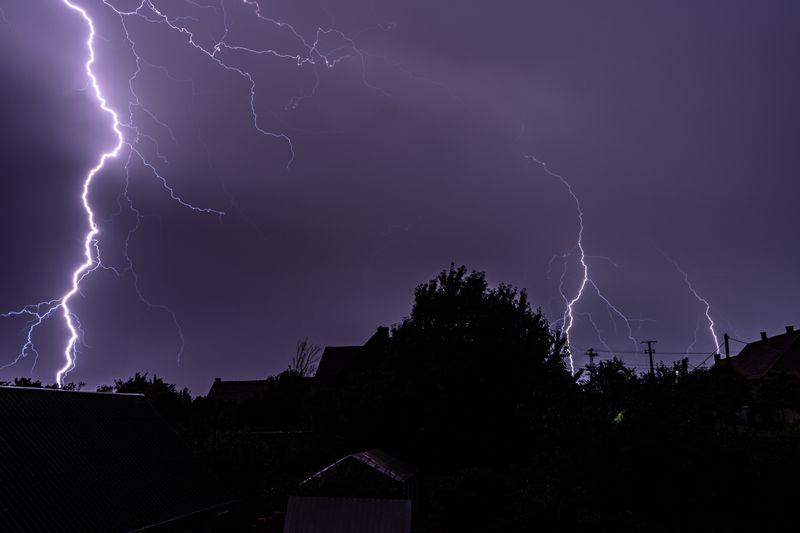Hurricane Hilary Intensifies as it Approaches Mexico and US Southwest
Weather Forecast
Tropical storm Hilary has rapidly transformed into a powerful hurricane as it moves closer to the southwestern United States and northwestern Mexico. Meteorologists are predicting heavy rainfall and strong wind gusts as the storm approaches. Within a few hours, Hilary went from being a Category 1 hurricane to a Category 2 hurricane, with sustained wind speeds reaching 165 kilometers per hour (105 miles per hour). It is expected to continue strengthening and could reach Category 3 status by the evening, with wind speeds of at least 178 km/h (111 mph). While currently located in the Pacific Ocean off the west coast of Mexico, the hurricane is expected to hit the Baja California region late on Friday.
Potential Impacts
The National Hurricane Center (NHC) has warned that Hurricane Hilary has the potential to cause significant impacts in the Baja California Peninsula and parts of the southwestern United States. Even after landfall, the storm could lead to flash flooding, especially in urban areas and dry stream beds known as arroyos in desert environments. In Baja California, up to 15 cm (6 inches) of rain is projected, with some areas experiencing up to 25 cm (10 inches). Southern California and Nevada are expected to receive between 5 and 10 cm (2 to 4 inches) of rain, although pockets of heavier rainfall up to 20 cm (8 inches) are possible.
Climate Change and Hurricane Intensity
Climate scientists have attributed the increasing intensity of hurricanes in recent years to climate change. Warmer temperatures result in more moisture in the air, allowing hurricanes to produce more intense precipitation. Additionally, rising sea levels make coastal regions more susceptible to storm surges, where the powerful winds of hurricanes push water inland. This combination of factors leads to more devastating impacts during hurricane events.
Public Health Implications
A recent study published in the journal Science Advances examined the impact of intense hurricanes on public health. The study analyzed 179 tropical cyclones in the United States between 1988 and 2019 and found that over 18,000 deaths were likely attributable to these storms. Hurricane Katrina, which occurred in 2005, was the deadliest event with an estimated 1,491 “excess deaths” – deaths beyond the usual expected number for an area. The study highlighted that coastal areas along the Atlantic Ocean and the Gulf of Mexico, where hurricanes are common, are home to both wealthy and socioeconomically vulnerable communities. The study also noted that official death counts during hurricanes can significantly underestimate the true toll, leading to variations in statistics. For example, the study found that the official death count for Hurricane Maria in 2017 was up to 70 times lower than the total number of excess deaths.
Editorial and Advice
Strengthening Preparedness and Resilience
As hurricanes continue to increase in intensity and pose significant threats to coastal communities, it is crucial for governments and individuals to prioritize preparedness and resilience measures. This includes investing in robust early warning systems, implementing effective evacuation plans, and ensuring adequate infrastructure to mitigate the impacts of flooding and storm surges.
Addressing Climate Change
The intensification of hurricanes is a stark reminder of the urgent need to address climate change. Governments and individuals alike must take proactive steps to reduce greenhouse gas emissions, transition to renewable energy sources, and adapt to the changing climate. International cooperation and collaboration are essential in tackling this global challenge.
Protecting Vulnerable Communities
The study on public health implications highlights the disproportionate impact of hurricanes on socially vulnerable communities. Efforts should be made to prioritize the needs of these communities in disaster response and recovery plans. This includes ensuring equitable access to resources and support, as well as addressing underlying socioeconomic disparities that contribute to vulnerability.
Investing in Research
Continued research into the impacts of hurricanes and effective strategies for mitigation and adaptation is crucial. By expanding our understanding of these natural disasters, policymakers can make informed decisions to protect lives and livelihoods.
In conclusion, Hurricane Hilary’s rapid intensification serves as a reminder of the increasing threats posed by climate change. As individuals, communities, and governments, we must prioritize preparedness, address climate change, protect vulnerable communities, and invest in research to mitigate the impacts of these powerful storms. Through collective action, we can strive towards a safer and more resilient future.

<< photo by Nikolett Emmert >>
The image is for illustrative purposes only and does not depict the actual situation.
You might want to read !
- Empowering Mayan Communities: Grassroots Fundraiser for Families in Guatemala
- Neymar’s Shocker Move: World’s Most Expensive Soccer Star Joins Saudi Team
- John Dodson Becomes BKFC Flyweight Champion, Proving his Dominance in Bare Knuckle Fighting
- China’s Evergrande Group Seeks Bankruptcy Protection in New York
- Carlos Alcaraz and rival Tommy Paul share private chat as tensions rise in tennis world
- State of Emergency Declared in West Kelowna as B.C. Wildfires Ravage the Region
- Wildfires in Keremeos, B.C., Merge to Form 10,000-Hectare Inferno
- Eastern China Rattled by Earthquake: No Injuries Reported
- Tornado Rips Through Ottawa, Leaving Destruction in its Wake




